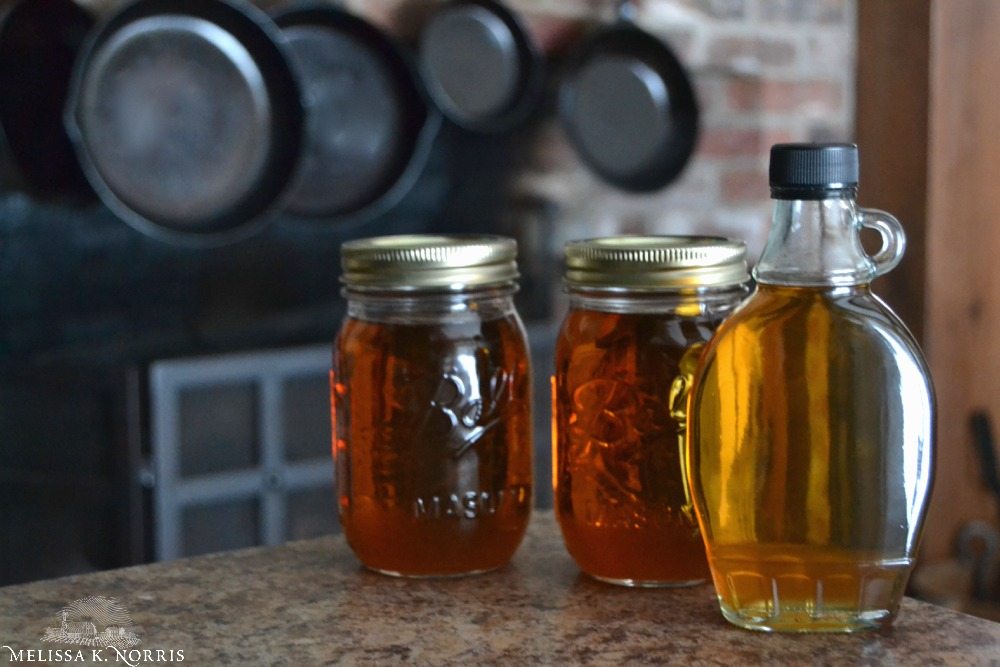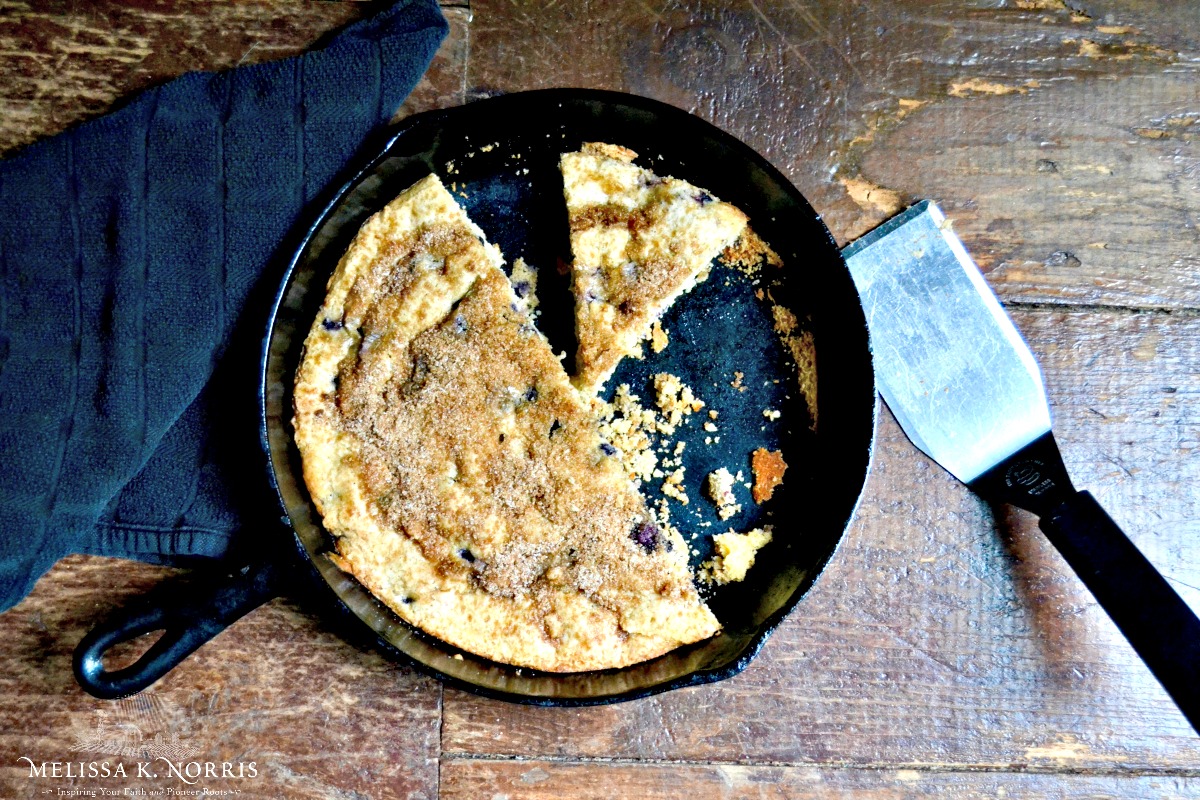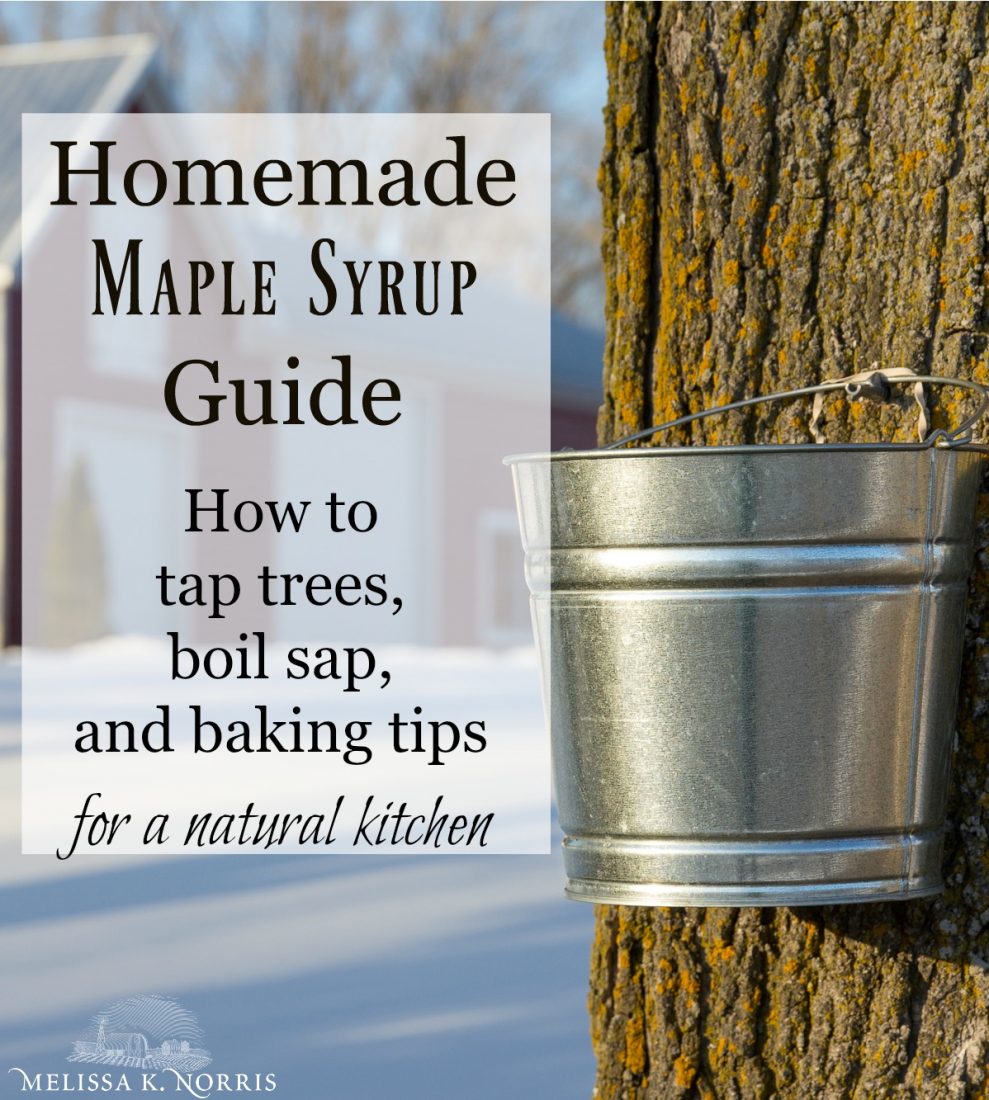
Learn how to make maple syrup in our homemade maple syrup guide. From learning how to tap your trees, boil down the sap into syrup, and our baking guide on using maple syrup in place of sugar in your recipes for delicious taste, but added health benefits! Whew, that’s a whole lotta awesomeness coming at ya.
Tapping maples for their sap and then turning it into syrup is an age-old process. The tree is tapped in the winter when the conditions are right for the sap to run and collected into containers.
Then the sap is filtered and boiled down into a concentrated syrup. You can take it a step further and make maple sugar, a shelf stable item that is no longer liquid and easier to transport if needed.
While it seems straight forward enough, there are some learning curves and tips and tricks you need to learn help make your first time a success. As well as learning how to turn any of your favorite baking recipes into maple syrup sweetened recipes.
Disclosure: I’m an affiliate for Michelle’s e-course and e-books and earn a commission if you decide to purchase using the 10% off coupon code: MKN, but regardless, we have a jam packed session for you with a ton of FREE help. Thank you so much!
Below is episode #125 of the Pioneering Today Podcast Homemade Maple Syrup Guide- How to Tap, Make Syrup & Baking Tips, where we teach families how to grow, preserve and cook their own food using old-fashioned skill sets and wisdom to create a natural self-sufficient home.
Health benefits of Maple Syrup
Maple Syrup is much less processed than sugar and has quite a few health benefits compared to regular table sugar.
- Contain antioxidants
- Contains trace minerals
- Contains vitamins
- Lower on the Glycemic index than sugar (though natural, it is still a form of sugar)
Michelle: The more I read, Melissa, I was just blown away. I couldn’t believe how healthy this stuff is for you. I’m going, “What? Wait, I thought I chose the healthy option when he was eating his disgusting maple syrup and I was eating my low sugar no calorie syrup.” I realized, “Wow, I’m getting nothing but garbage in my syrup and he is getting all these antioxidants and all these minerals. Maybe I should try it.”
It was delicious. Knowing how healthy it was for me, seeing this process, that it had come out of the tree in my backyard. In fact one tree we have a tire swing on. This is a beloved tree of ours, and it literally produced this amazing deliciousness that was on my breakfast table. I was hooked. And then I suddenly realized, not only do I want it on my pancakes, I want to figure out how can I use this in the kitchen for what we’re baking. The rest is history.
Want to learn how to tap your trees for sap, turn it into delicious syrup, and bake wonderful foods for your family with a natural sweetener from your own land?
Check out Michelle’s course and/or e-books by clicking here and use coupon code MKN at checkout for 10% off.
What time of year do you tap maples for syrup
Melissa: What’s the window for tapping that you can usually get a decent amount of syrup?
Michelle: The timing is always different. This will be only our third year that we’ve actually tapped. But the timing I’m told is always different.
It can range anywhere from end of January that you might possibly be able to start tapping in New England, until actually end of February before you’re ready to start tapping. We typically get our most in March, we get the most amount of sap, because here is just stays cold so long into January or February during the day.

You have to have at least 40 degrees all day long to be able to get that sap really running the optimum time and you need to be freezing at night. It has to stay below freezing all night long, but you’ve get to get it to 40 or above during the day. We find that typically we have about four to five weeks that we find those temperatures are just right.
What size of maple tree gives the most sap
Melissa: I’m going to assume that the larger the tree, and I could totally be wrong, I have not done research on this, but the larger the tree the more sap that you’re going to get out of it.
Michelle: That’s true if it’s a very healthy tree and if it’s located in the right area, as far as it’s getting enough sun, it stays warmer. You can have a really large old tree that’s survived in the heart of your woods that’s just not getting enough sun for it to be flowing as fast.
We have a giant tree that we thought would be great and it gives us very little. I’m guessing it’s because this tree is probably a couple hundred years old, so it’s just not any longer in its prime. It also depends on the quality of the wood.
When you go to tap, when you drill in to make your hole, you can tell by the shavings that come out if it’s a really high quality younger tree, because it’s going to be a really pretty light brown color. But if you’re seeing something that looks old or something that looks to green, then you’re either on the too old or too young spectrum.
Can you tap other types of trees for syrup
Yes, sugar maples are considered the best because they have the highest sugar content, meaning you’ll get more syrup with less sap, but you here’s a brief list of most commonly tapped trees for syrup:
- Sugar Maple
- Maple
- Birch
- Walnut
- Alder
What does it cost you to make your own maple syrup per jar
Melissa: I love that you guys actually took into account the amount of cost the first year. Like you said, it was like $200 per jar. Because there usually is a money investment, not always, when we’re getting started with something. I think it’s always important to kind of really, to calculate out your cost. So you went from being expensive jars to begin with. What would you estimate that your cost is now per jar?
Michelle: I was exaggerating with the 200, honesty it was probably maybe close to 100 though that first year. But now, first of all with our reverse osmosis filter, and on my website I have links to how you can make one, with that we literally, every time we measured it we had half the amount of sap before we had to boil it.
That reduced our boiling time in half, and that is our biggest expense because we do boil it over propane, so depending on the cost of propane that’s going to be the biggest expense we put into it.
I would estimate off the top of my head that maybe we have … I would guess $8 to $10 in a jar of syrup.
Melissa: Are you doing a pint or a quart? What’s your jar size?
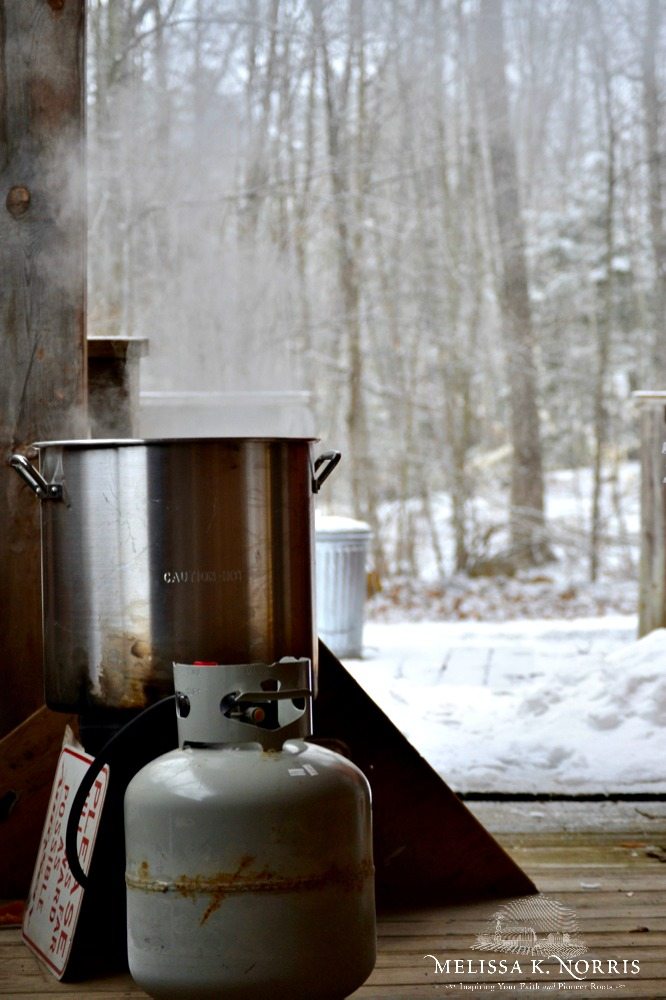
Michelle: Pint would be $8 to $10 probably. If you get up to a quart, I’m sure it would be $15 or $20 that we’re spending on it.
How much sap do you need to produce syrup
Melissa: Got you. Approximately, say you have a half gallon of sap, how much does that equal out to into the finished syrup?
Michelle: Typically, eight cups of sap will be one cup of syrup.
Melissa: So you’re really concentrating it down when it’s going through, when you’re boiling it down.
Michelle: Yeah, yeah, yeah, and that’s for sugar maple, which of course has the highest sugar concentration. You can actually tap any maple. You can tap a whole bunch of trees. I have 22 that I list in my book that you can tap, that make very delicious syrup. But the sweet … I’m sorry, the sugar maple is going to give you the most sugar content, so you’re boiling less of it down.
Melissa: So you’re going to get a higher volume if you’re using a sugar maple versus like we were trying to tap an alder and then just a regular maple.
Michelle: Exactly. Typically, one five gallon bucket, we collect that, on a good day we collect two of those per tree. But that’s on the best days, which we only have maybe four or five of those in our whole run. But typically in that four to five week window we’re getting about a bucket of sap a day from a maple tree.
That five gallon bucket we find after we’ve run through the RO filter, and after we boiled it down outside, and then we bring it inside and boil it down more and filter it into our jars, it gives us about one breakfast amount of syrup. So I find that one bucket from our maple tree gives us about one breakfast of syrup for our family of six.
Melissa: Wow, that is fascinating. Because it would seem like, if I had a five gallon bucket of sap, I would be thinking, “Oh my goodness, this is going to be quarts worth.”
Michelle: Right. No.
Melissa: That is absolutely fascinating, which when we go to the store, like you were saying, the real maple syrup it can be pretty spendy, but there’s a reason when you hear about all of the work and the volume that you have to collect, and then when it’s actually put down into the finished product, that’s why.
Michelle: Absolutely, and on top of that, yes you’re paying more for it, but when you realize that maple syrup is considered one of the world’s healthiest foods, who wouldn’t want to pay more for all the antioxidants you’re getting and all the minerals in the high concentration that you’re finding there.
It makes sense again, because this is how God intended things. He put the sap in the trees for us to take out and sweeten our food. Of course it’s going to be our best option that we have.
Melissa: I completely agree. That’s the fascinating thing when you’re using things like black-strap molasses for example, raw honey, real honey, the real maple syrup, those as your real sweeteners, there is immense health benefits that come with each of those different things. There’s actual vitamins and minerals and antioxidants. There’s much more specific profiles if you were to dive into each one, but you do not get that when you have high fructose corn syrup.
When you’ve got regular table cane sugar you’re not getting those benefits that you get from these other ones.
Plus, these are things that you can produce on your own land, especially in regards to … Well, depending upon the type of trees that you’ve got, but you can easily be done at home when it comes to honey and with maple syrup.
So it’s something that you can be … I’m assuming you guys are completely self-sufficient with the maple syrup. I doubt you’re buying any from the store, so that’s you providing enough to take your family through for the whole year.
Michelle: I wish.
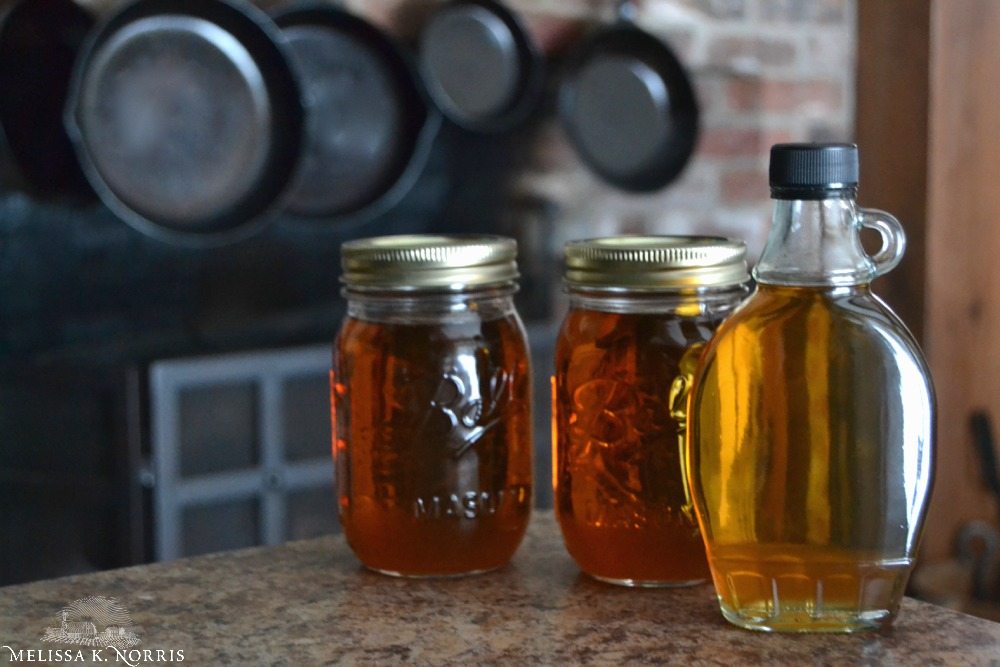
Melissa: No?
Swapping out sugar for maple syrup in your baking and cooking
Michelle: No, the problem is it’s so addictive Melissa, that okay we made 33 jars of it, but we love it so much. You know, when I learned of valuable it is as a health benefit, we’re putting it in everything that we bake almost. No, I’m buying way too much. In fact, true story, my 17 year old went on Amazon last week to see how much we can get at a bulk price. No, we are not self-sufficient. We are just more addicted than ever to maple.
Melissa: I love it. I love that you’re completely candid and honest about it. That is hilarious. So, what did she find? Did she find that you guys could get a large bulk amount for a really good price?
Michelle: She is my major homesteader. She’s the one who really pushed my family into the whole homesteading lifestyle because she was so enamored with it. So she actually got me reading up on everything. My husband got me into maple syrup, Kayla got me into chicken, ducks, rabbits and cows.
But she found that the bulk prices unfortunately are still rather expensive. I’d have to buy, I think it was … I think if you buy five times as much you would save … You know what, I’d have to ask her. But I was surprised that it was still … I’ve got to be honest, it was still expensive. I don’t think there’s any way to get this great healthy sugar for cheap. You know, that’s not usually how things work in life anyway. Usually the best things aren’t cheap, right?
Melissa: Very true. Where we buy our maple syrup … well, it depends, sometimes we have a local co-op that I can get a really good deal on it. But a lot of the time I can get it from Costco. They’ve got an organic brand and so I will get our real maple syrup from Costco. Which is, you know, it’s Costco size jug, we’re not talking gallons or a five gallon bucket or anything. But that’s actually where we get ours, so I was just curious if you had … I didn’t assume that you were buying it,
Michelle: Right. No, on my site I do link to some local options here in New England, but as far as best price, unfortunately I don’t think there is a great price anywhere.
I know that you mentioned honey, I wanted to tell you quickly that I was shocked when I found out, I love honey too by the way, that it actually has almost twice the amount of calories as maple syrup.
There have been a lot of studies on honey, and of course it’s an amazing for … I shouldn’t say substitute, it’s an amazing thing to choose instead of refined sugar. But unfortunately a whole lot of studies haven’t been done on maple syrup.
The assumption is that a lot of the same qualities you find from honey you’re going to get from maple syrup, but there haven’t been nearly the amount of studies done on it.
But comparing, 21 calories a teaspoon of honey, to 11 calories in a teaspoon of maple syrup, that’s another reason that I went, “Wow, I need to look into using this in baking.” Because when you’re putting a cup of it, or half a cup of it, in cakes or cookies, that makes quite a big difference, the 21 calories in a teaspoon versus 11 in a teaspoon of maple.
Melissa: That does make a big difference. I actually didn’t know that. I do know that honey, actually if you take a cup of honey and a cup of sugar, honey is considered … I believe it’s even considered sweeter than sugar. I would have to look up the macros on that, again, but I’m almost positive that it actually is even considered sweeter. So a lot of time I know if you’re going to be converting a recipe and you’re using honey, if it’s a cup of sugar you won’t actually use a cup of honey. You’ll bring that back down a little bit.
How to alter baking recipes from sugar to maple syrup
But that actually leads perfect into my next question, because you didn’t use to cook with maple syrup, but now you mentioned you’re using it a lot in your baking and using it in your foods. If you’ve got a regular recipe, just a baking recipe, say it’s a cake recipe and it calls for half a cup of sugar, a cup of sugar or whatever. Do you have any things that you’ve discovered switching over? Some kind of rules for converting to using maple syrup, some of your favorite recipes.
Michelle: Definitely. Unfortunately I do find that it does vary from one recipe to the next, but in general I think like honey you’d be using less syrup than you would sugar.
Converting to maple syrup guidelines:
- If you had a cup of sugar in a regular recipe, you would want to substitute it with somewhere in the neighborhood of two thirds to three quarters cups of maple syrup.
- Find somewhere in the recipe to reduce the liquid by like three tablespoons roughly, because obviously you’re adding a liquid sugar when you had the dry sugar before.
- Turn your oven down typically about 25 degrees, because when you’re replacing it with maple syrup it caramelizes at a lower temperature than sugar does, so you want to keep that in mind. Of course that would lead to having to bake it a little bit longer too.
Turning maple syrup into maple cream and maple sugar
Melissa: That is excellent. I did not even think about the caramelization factor in there when you’re swapping it out, the sugar for maple syrup. Those are fabulous tips.
Michelle: Well I love making … actually more than the syrup I love making maple sugar and maple cream is my personal favorite. Basically the things you need to know to make those two things … Well, I have e-books about both of them and you can break it down through that. But basically it all comes down to the temperature that you’re boiling it at.
With maple syrup, temperature is so important to get your different products, because of that caramelization factor. That’s why I knew, “Okay, if I’m putting this in my baking I need to think about the temperature and figure out.” I found that roughly about 25 degrees lower is what you want to do when you’re baking with syrup.
Melissa: Okay, maple cream. Walk me through what … Tell me about this wonderful thing I’ve never heard of, or never had before.
Michelle: Maple cream is … It’s heaven when it comes to sweeteners. Honestly, I often wonder what is good going to be like in heaven, and I’m not exaggerating when I tell you I honestly thin that there will be maple cream everywhere. I think it’s wonderful. I love putting it on anything, like bread and bagels and cookies and shortbread.
You have to have syrup to begin with, and of course for people who don’t tap, of course they can purchase just all natural maple syrup.
You have to boil it for a certain amount of time at a certain temperature, so you have to watch carefully all those factors. Then, once it reaches the magic point, you let it cool a little bit, and then you stir it nonstop for like 15 minutes, or you use your KitchenAid to mix it up. Then it’s like absolute magic. If you turn away you’ll miss the magical moment. There’s like this puff and you get cream. It’s wonderful.
Melissa: Really is like thick and fluffy, like a cream?
Michelle: Well, I wouldn’t call it fluffy. Let me see, it’s not as heavy as cream cheese, but-
Melissa: But it’s much thicker than a syrup obviously. So you’ve almost taken it … Temperature-wise, it sounds like you’ve taken it almost to, maybe not quite as far as the soft-ball candy stage, but kind of going along those lines.
Michelle: Exactly. For the candy you want to be I think about 240.
Melissa: Okay, so it’s a step below taking it to soft-ball stage.
Michelle: Correct.
Melissa: That’s fascinating. No, I had never had it. Maybe because it’s a west coast versus east … I don’t know, or maybe I just have not branched out much in my culinary areas, because we don’t have the sugar maples out here. We have maple syrup but it’s not like a natural regional thing. I’ve heard, creamed honey, yes, but I never thought of doing the creamed maple or the maple cream. That’s fascinating, and pretty easy to do it sounds like at home.
Melissa: I will. Now the next thing I want you to talk me through though, because I thought this was fascinating too. We’ve talked about the maple cream, but making your ample sugar, because way back, they did make their own sugar.
I was just reading with my daughter not too long ago, we read through The Little House on the Prairie series. One of my favorite ones is actually Farmer Boy, because they talk so much about doing all of these things. Ma Ingalls, the white sugar, the table sugar that we kind of think of in most homes or modern America now, sugar is the white sugar.
That was only set out for when company came. That wasn’t what they used everyday in their cooking or their baking. But they used the brown sugar that they would make.
How to make maple sugar
How do you take your maple syrup and then bring that into a sugar form? Is it just cooking it longer? Or is there another process that happens?
Michelle: No. It’s actually along the same lines as the cream and the candy. You just have to get to the right temperature for the right amount of time. For sugar, I think it’s … You know, I should have had all my notes in front of me. I think it’s like 250, 252 maybe. I can’t remember the length of time, but again, like the cream, you let it cool down a little after it’s reached that right temperature, and then you stir it nonstop. You get this poof and you have your beautiful sugar.
I also loved Farmer Boy when my girls were little. The Native Americans, of all the ways they could possibly sweeten, maple sugar was their go to, because unlike maple syrup, maple sugar is so easy to transport, to store.
They didn’t have to think, have any process of canning like we would do for syrup. So maple sugar was the way that Native Americans would sweeten everything. And then they’d make a sweet syrup, I’m assuming probably just from water and maple sugar for their baking and over their meats and lots of things to sweeten it.
Full step by step tutorial click here –> how to make maple sugar
Melissa: So once you get it to the sugar form, then it’s just like regular sugar, you know, brown sugar, everything like that. Then it’s shelf stable.
Michelle: Exactly. There are certain things that you want to do to make sure it doesn’t stick together, or turn like a big hard glob on you. I do break down some of that, and there’s something called a creep test that you can do to make sure it’s dry enough before you put it in your jars. So I break down all that kind of stuff in my e-book about making maple sugar
I actually made the e-course over the summer last year, when the Self Reliant School asked if I wanted to be part of the Back to Basic summit. I said, “Well yeah, if I can do something about maple syrup,” and they said, “Sure.”
I put together this 35 minutes course that basically is an inspiration, if people are not quite if they want to do this or if they’re wondering about the health benefits of maple syrup. It’s a 35 minute course that walks you through some of the mistakes that our family made and why we choose to this, and then it gives you their eight steps. I’ve broken it down into eight steps that we go through, from the tap to our table. I break it all down in the course.
Favorite maple syrup treats
Do you have some absolute favorite recipes or some of your favorite things? Which, I know you said you love maple syrup in everything, but if you had to pick let’s say your top three, what would your top three recipes with the maple syrup be?
Michelle: Well, I love maple fudge because it is so, so easy and it’s absolutely delicious. I love, I call them the best ever maple scones, because I’m not a scone person, so I actually love these because it’s the first time ever I ate a scone and I went, “Wow, that’s actually good.”
Melissa: The people who are like hardcore scone fans are just like, “What?” No, I’m teasing.
Michelle: Well, if you’re a hardcore scone fan believe me, you absolutely have to get my totally free e-book. Download it from my website and try the best ever maple scones, and then maybe you’ll decide you’ve reached scone perfection.
But I also love, I have a recipe, my husband’s grandmother had in her little cottage in Romney, New Hampshire, we would go for vacation, I discovered it tucked away in her handwriting in this book that I don’t know if anybody had opened it for 15 years. She had passed away at the time, but I came across this and I thought, “Oh my gosh, this sounds delicious.” This is for blueberry … well she called it, “Melt in your mouth blueberry cake.” It really is that good.
Get the recipe for Melt-in-Your-Mouth Blueberry Cake by clicking here.
When I started baking with maple that was the first thing I thought of that I knew I wanted to try with maple, and it is amazing. It gets even more melt-in-your-mouth-ish with the maple. She baked it in cast iron and I always make our cake in cast iron too. I always think of grandma when I do it. It’s just amazing. Another one is maple popcorn instead of caramel popcorn.
Melissa: Fun.
Michelle: Yeah. What else do I love? I found a recipe from my father’s youth that fell out of a scrapbook he had kept in high school. It was all folded up, and you know this paper falls out and I have this excitement of, “Oh my gosh, what is this paper.” I’m unfolding it with anticipation. I open it up and it’s for … Well, it’s for donuts basically.
I thought, “Oh my gosh, these donuts are like totally old fashioned, the way our grandparents made donuts donuts.” I brought my 17 year old into the kitchen and we right away tried out these donuts and they’re amazing. Then I said, “Okay, we’ve got to add maple,” so we added maple glaze to them. They are amazing.
Melissa: My goodness.
Michelle: Those are some of my favorites. That is in my book called Sweet Maple.
Melissa: I want to thank you so much for coming on today. When you’re dealing with these real food ingredients they do cost more money, and so it’s so frustrating when you don’t necessarily know how to convert that recipe right and you feel like you’ve kind of wasted … most time they’re still edible, but you know, when you kind of wasted those ingredients in a way or it doesn’t turn out how you wanted. So thank you for sharing those tips because any time we can save someone some money and some heartache, it’s so worth it.
Considering tapping your maple trees
If anybody is considering tapping and they have lots of questions, my number one resource that I would highly recommend is a Facebook group that I actually admin and run. It’s called, Maple Syrup Making. There are experts on there and also newbies who are learning it all too. It’s a great resource for anybody who’s considering it and has questions.
Melissa: That is fabulous. Thank you. Because if my husband and I decide to tap again, which now I’m thinking we’re going to have to. I’m going to keep an eye on our temperatures though and document it, see if we have any days that are going to be right in that range, above 40 and then freezing at night. I think we’re going to have to see if we can anything out of our alders and then some of our maples. And now I’m going to have to go and look up and see if sugar maples will grow, because I might just have to go plant some on our homestead.
Learning how to make maple syrup
When we first started he did everything wrong. I mean really, he did. So the first year, I had no interest at all. I mean I was still totally not a maple syrup person.
But the second year, is when he said, “Okay. We’re either totally going to call this a failure, and I’m going to pretend I didn’t do it. Or we’re really going to make something of it this year, and I’m going to get it right.”
He spend that whole 10 months in between times reading, talking to people. We do live in maple syrup country so we have plenty of experts to find and talk to and he was ready.
The second year we tapped 24 trees and he even added a whole new process with lines that he was running, so it was a little easier to collect every evening.
Full step-by-step tutorial click here–> how to make maple syrup at home guide
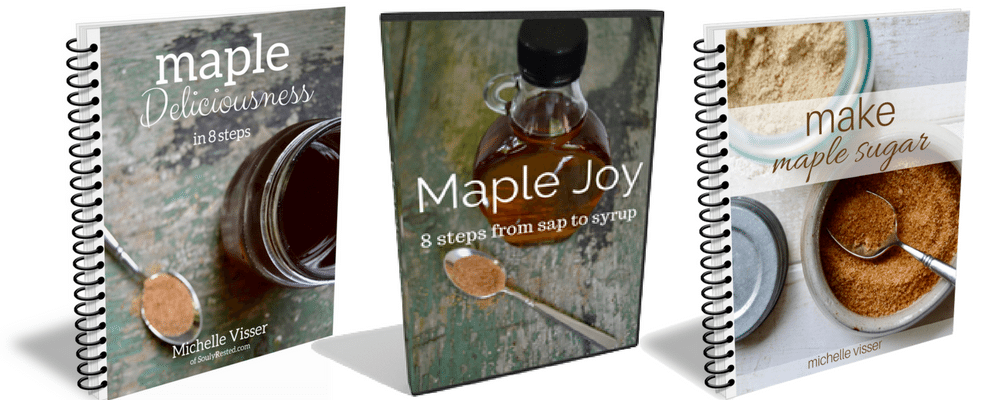
Learn from those who have went before
He learned the right way to filter everything. He learned what a reverse osmosis filter is and he built one. In the end we wound up with, I think it was like 36 jars, and they were beautiful.
“This fun, friendly group is open to any and all maple enthusiasts who would like to learn to tap a few trees or simply gain some fascinating insights and yummy recipes.” Click here to request joining the FB group
Want to learn how to tap your trees for sap, turn it into delicious syrup, and bake wonderful foods for your family with a natural sweetener from your own land? Check out Michelle’s course and/or e-books by clicking here and use coupon code: MKN at checkout for 10% off.
There you have it, how to tap your trees and how to make maple syrup at home. Plus, even if aren’t able to tap, how to use maple syrup in your baked goods and as a natural sweetener!
Additional Resources mentioned in this episode
5 Rules for Foraging Wild Edibles + 25 Wild Edible Plants
